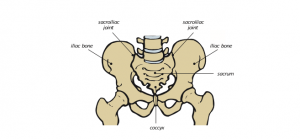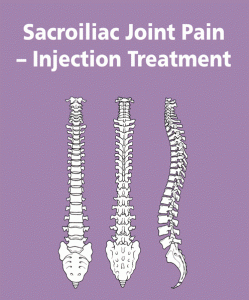The two sacroiliac joints are positioned in the lower back (lumbar spine), in between the triangular sacrum and iliac bones of the pelvis. They work as a shock absorber to reduce the stress on the pelvis and spine and to transfer the load of the upper body to the lower body, when we stand or walk.
The pelvis


Just like any joint in the body, the sacroiliac joints can become:
- inflamed due to the wear and tear on the cartilage surface and resulting arthritis
- dysfunctional, where there is either too much or too little movement, or
This can cause pain and stiffness, directly over the sacroiliac joint itself and the lower back, which can radiate (travel) behind the hips and into the groins and down the back of the legs. The pain suffered from sacroiliac joint degeneration can often be mistaken as a problem with the hip joint, or lumbar spine, as it can be very similar.
If symptoms are prolonged and interfering with day-to-day life, an injection of anti-inflammatory medicine direct to the source of irritation, can be beneficial and provide excellent pain relief. This should be followed a week or so later by an ongoing exercise program to stretch and strengthen the muscles and help reduce the likelihood and severity of pain returning. Injection therapy should not be considered the only treatment for sacroiliac pain. Continued rehabilitation and stronger muscles for your own ‘internal corset’ is vital for the future ‘health’ of your spine and pelvis. See pages 6 – 8 for exercises to help improve sacroiliac joint pain.
About the procedure
The procedure is often done under local anaesthesia (to numb the injection site and surrounding area). Your surgeon may decide that intravenous sedation (so the patient is unlikely to be aware) is required and may be given by an anaesthetist. You will be asked to lie down on the operating table on your stomach, usually with your head facing to one side on a pillow. The skin on the back is cleaned with antiseptic solution (this may leave your skin orange from the dye). Live X-ray is then used as guidance to direct the needle into the sacroiliac joint capsule. Radiographic contrast (or dye) is often used to outline the nerve root before a small volume of corticosteroid and / or local anaesthetic is injected. This usually only takes around 5 minutes to carry out, but for the whole procedure to include sedation, positioning, injection and x-rays the process will be longer.
We monitor for a minimum of 2 hours post procedure if sedation is used. If you have sedation you will be required to be nil by mouth (starved/fasting) 6 hours prior to your procedure. You may however drink water up to two hours prior to your injection. Please keep in mind you will be at the hospital for most of the day.
Usually patients are just admitted as a day case surgery as a rapid recovery from any sedation / anaesthetic is expected. Be aware that the local anaesthetic given may cause some temporary leg numbness or weakness for a few hours. You will need to be careful when getting out of bed, that any weakness does not cause your leg to ‘give way’ and for you to fall over.
You should continue to take your usual pain relief medication until you begin to feel the benefit of the corticosteroid. It is important not to stop taking certain pain relief medication suddenly, such as, morphine or neuropathic medication (gabapentin, pregabalin or amitriptyline). It will be necessary to gradually ‘wean’ yourself off them – your GP or consultant can advise you if necessary.
When sacroiliac joint pain has been confirmed beforehand, more that 85 – 90% of patients will experience significant benefits from these injections. However, the duration of benefit is variable and may last a few weeks, months or years.
For a considerable number of patients, the injections can provide excellent pain relief enabling you to continue with physiotherapy, keep active and possibly lose weight if necessary. However, some patients who have had an episode of sacroiliac joint pain are at an increased risk of having a further episode. It may be possible to repeat the injections, if the first has been helpful, although not straight away. Most specialists would wait a few months before repeating them. If the symptoms have not improved after six weeks or the relief only temporary up to that point, then in certain circumstances, the next stage may be to consider radiofrequency denervation (a procedure which involves the burning of the sacroiliac joint nerves, to interrupt the nerve supply and pain messages).
If however, the injections / physiotherapy or radiofrequency denervation do not improve the symptoms, then future treatment may include surgery to fuse (join together) and stabilise the sacroiliac joints.
Risks and complications
Fortunately, there are very few risks associated with sacroiliac joint injections. Very uncommon risks include:
- You must inform your consultant if you are taking tablets used to ‘thin the blood’, such as warfarin, rivaroxaban or clopidogrel. It is possible you may need to stop taking these before your injection. If your procedure is scheduled with less than a week’s notice, please check with your consultant or nurse which drugs need to be stopped to prevent this being delayed
- Although this is rare, it is important that the skin on your back is clear of skin conditions like psoriasis or eczema as these can increase the risk
- facial flushing or (ladies only) interference with the menstrual cycle or post-menopausal bleeding. This can be a temporary side effect of the steroid
- a rise in blood sugar levels for a few days for people who have diabetes.
- allergic reactions to the medications or radiographic contrast (dye) used. Serious consideration is necessary for patients who are known to have chronic kidney disease (CKD) as the dye can adversely affect the kidney function, which is rare cases could lead to kidney failure.
- Risks of sedation. During your sedation your breathing may become slow, this is particularly common in deep sedation, but is a risk whenever sedation is used. Your anaesthetist is skilled in monitoring you and can support your breathing if required. It is very common that your blood pressure may drop by a small amount. It is very common to be left with a small bruise where your cannula was placed. Feeling sick or vomiting is uncommon. There is a small risk of stomach contents going into your lungs therefore it is vital to follow fasting instructions to keep this risk very low. Any allergic reaction to the sedation drugs is very rare. You may be at a higher risk of falling, especially if you are elderly. It is common for sedation to affect your judgement and memory for up to 24 hours.
Sometimes however, it is difficult to place the needle and inject directly into the joint space due to the presence of bony overgrowths. In this situation, the pain relief from the injection may not be quite as effective.
What to expect on the day
Your admission time may be early (i.e. 07:00am) as it is likely that you are part of an operating list in theatres. The reason for this is, so all patient for that day can been seen by the anaesthetist and consultant. This also gives time for a comprehensive admission to the ward and getting changed ready for theatre. However, unavoidable things can happen on the day and there may be a wait. You will walk (if able to) to theatre with a ward nurse and porter to be checked in with the anaesthetist and theatre team.
After the injection, you will be taken to the recovery ward on your bed for a short while, where a nurse will check your blood pressure and pulse. Oxygen may be given to you through a facemask to help you wake up, if you were given sedation. You will then return to the ward. When ready you will be offered a light refreshment before you are discharged home.
Going home
If you have had intravenous sedation, then you will usually be monitored for around 1-2 hours on the ward depending on your sedation type, how you are feeling, and once you are up and about. If you have had intravenous sedation, you should not drive for 48 hours and a responsible adult should remain with you overnight. Please arrange for either a friend or relative to collect you from hospital.
Work
You may be advised to take the next day off work, if you had intravenous sedation, however, you may feel that you need longer and if the pain persists.
It can take several weeks before the full benefit of the injection takes place. The hospital can give you an off-work certificate, remember to request this during your admission or you can call the ward if you forget alternatively, you can ask your GP.
Follow-up
Your surgeon will advise you if you need to attend clinic after your procedure, or how to request a further clinic review if necessary. If you have any queries about the information in this booklet, please discuss them with the ward nurses or a member of your consultant’s team.
It is advised to keep a post-operative diary to monitor the outcomes of the procedure to help your surgeon ascertain if the injection is positive one.
- When did the improvement start after the procedure?
- What percentage of improvement have you had?
- How long has that improvement lasted? (from date to date)
